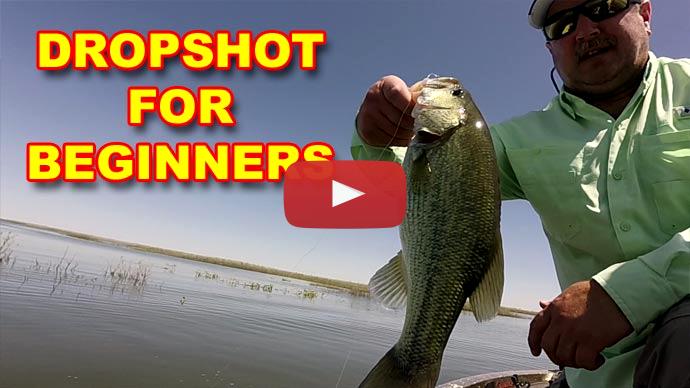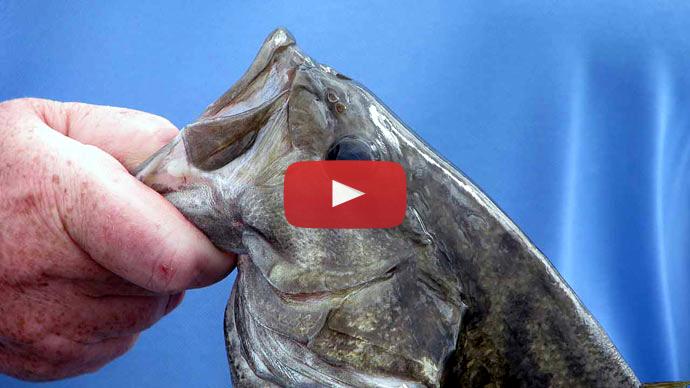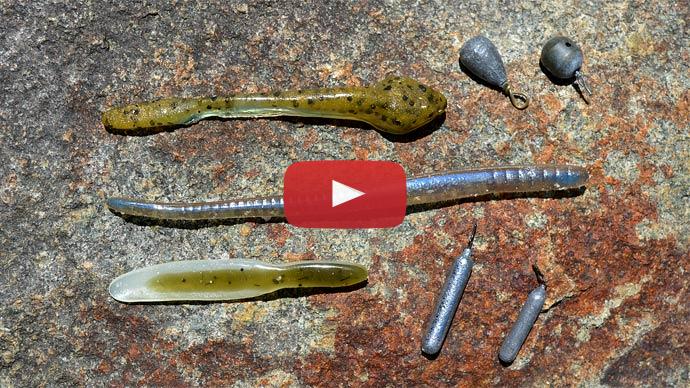Hey folks. Glenn May here with BassResource.com. Today I wanna talk to you about setting the hook on a drop shot setup. It's a little bit different than what you would expect. I wanna tell you how to do it, and then I wanna teach how to learn how to do it, okay? How do you train yourself to set the hook this way? It's a different way of doing things.
So, first of all, when you're drop-shotting, you're using a light line, six-pound test, maybe eight-pound, but six-pound test is what I use. Nice, medium power rod with a moderate action so it's got a lot of bend in it.
Why? Because you're using just a small 1/0 hook or a one hook. It's a thin wire small hook. So you don't need to set the hook super hard. This is needle-sharp thin wire.
When you set the hook on this, if you do it like you're...say when you're jig fishing or fishing a worm, those are a big thick 4/0, 5/0 thick wire hooks when you're flipping and pitching. You square up, reel them out, boom, and you hit him really hard, you might break your line, but you could also bend the wire, bend that hook out, which I've done, or you might just rip it right out of the fish's mouth because it's such a thin wire. It doesn't have a lot of grip, a lot of bite to it. It's a small hook. You could literally just rip it right out of his mouth. So that's the wrong hook set.
There's two different ways to set the hook on a drop shot. One of them is if you got an open hook, an exposed hook, and that's either when you have the bait nose hooked, or you've got the bait threaded onto the wire and to the hook where it's like a jig. It's an exposed hook.
With those, you don't even set the hook, okay? You heard me. You really don't set the hook. What you do is something called the “reel set”, where you just reel it down, you feel the bite, and you just reel faster. That's it. Or maybe just pull the rod just a little bit while you reel faster. That fish...that's it. That's such a sharp little needle hook, it'll penetrate and you've got him.
It's funny how you're so accustomed to setting the hook really hard, and this is like the opposite, but it's very, very effective.
Now, I like to fish drop shot baits where I've Texas rigged the bait onto the hook. So it's actually...the hook is actually buried in the bait a little bit. That requires a little bit different of a hook set. With that, when you feel the bite, it's a quick lift. I'm not even like...I'm not hitting it really hard. It's just a quick lift, and then I reel. So it's...you're letting...the rod bends a lot, so it looks like it's more work. I'm actually hitting it harder than I really am because the rod absorbs a lot of that hook set, but it's just quickly lifting up. It's not super hard. I'm not laying my body into it. I'm not putting a lot of English into it. It's just a quick lift, and then reeling in. It's just enough to pop that hook out of that bait and penetrate the fish's mouth.
"Fine and dandy," you say. "Great, Glenn, I've been watching these videos on YouTube and I've watched you and the problem is when I'm out there on the water, soon as the fish hits, bam, I set the hook and I do it all wrong, and I forget how to do it."
So here's how to train yourself on this new technique. This is a new skill you're learning. This isn't just a modification of a hook set. It's a new skill. So here's how I go about doing it. This is what I suggest.
When you're fishing this bait, think to yourself, "as soon as the fish strikes, don't set the hook," okay? You heard me right. Don't set the hook. Just don't even reel. Don't do anything. You feel that fish bite, all you wanna do is get a little bit of tension on it and just hold it. Just hold. Don't reel, don't pull, don't do anything. Just hold onto it.
I want you to experience how long it is that that fish will hold onto that bait. Now sometimes they'll hang onto it a real long time and you reel up and guess what, you've got a fish. They actually will hook themselves that way. You can catch fish that way.
But the point here is I want you to learn how long it is when a fish bites to when they let go, because that's your window of opportunity. Because what happens is we're so used to setting the hook, we've trained ourself so much as soon as the fish bites, bam, set the hook right away.
It's a reflex. We've done it so much for so long, it's a knee -jerk reaction. We don't even think about it. There's no thought process.
What you have to do to learn this new technique is you have to think for a second, "What am I suppose to do?" So you have to have that buffer, that little bit of time when you feel the bite, to when you actually set the hook.
That little tidbit is what you're gonna need...once you've done this a few times, now you understand, there's a little window of opportunity when you feel that bite, stop for a second, pause, how am I supposed to do this hook set, that's right, just lift up on it, and start reeling, or give it a little bit of a quick lift to start reeling. You have a moment to think about how you're supposed to do it.
That's how you train yourself for this new skill, is getting away from that reaction knee-jerk hook set and retraining yourself on how to set the hook properly. Once you learn how to do this on a drop shot, you're gonna hook a lot more fish, get a lot more fish in the boat, and you're gonna be a lot more successful angler. For more tips and tricks like this, visit BassResource.com.



